Financial Management and Investment Appraisal Report for Business
VerifiedAdded on 2020/04/07
|11
|1714
|60
Report
AI Summary
This report provides a comprehensive analysis of financial management and investment appraisal, focusing on two investment opportunities. It begins with an assessment of a short-term business venture, including the preparation of sales, labor, and cash budgets to forecast financial performance. The sales budget projects revenue from meals and drinks, the labor budget estimates staffing costs, and the cash budget tracks cash inflows and outflows. The report then delves into investment appraisal techniques, evaluating a long-term investment using Net Present Value (NPV), payback period, and Accounting Rate of Return (ARR) methods. The NPV analysis calculates the present value of cash flows, while the payback period determines the time required to recover the initial investment. The ARR assesses the profitability of the investment. The report concludes by comparing the two investment options, providing insights into the decision-making process based on financial metrics and business objectives. The report also includes a detailed bibliography of the sources used.
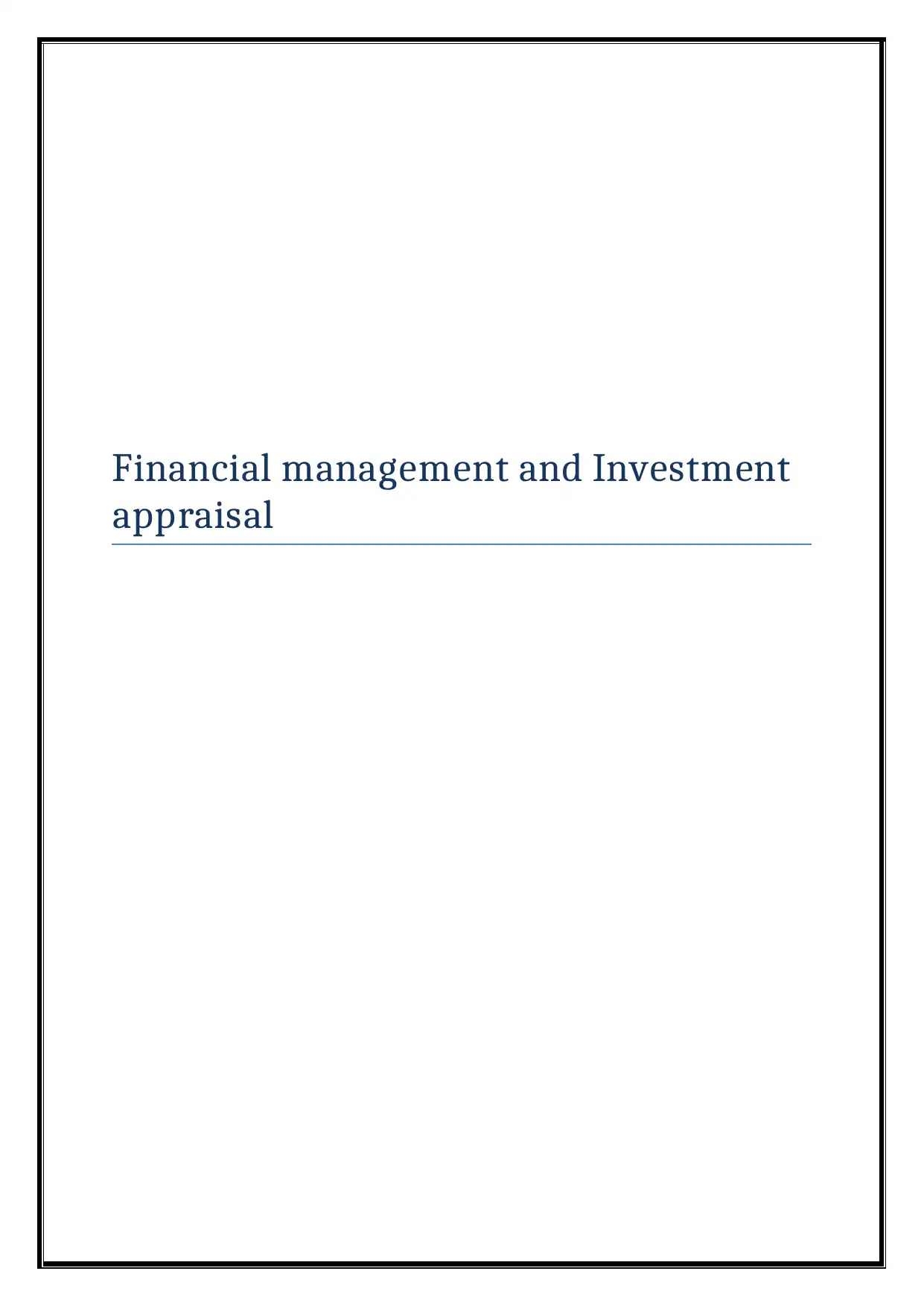
Financial management and Investment
appraisal
appraisal
Paraphrase This Document
Need a fresh take? Get an instant paraphrase of this document with our AI Paraphraser
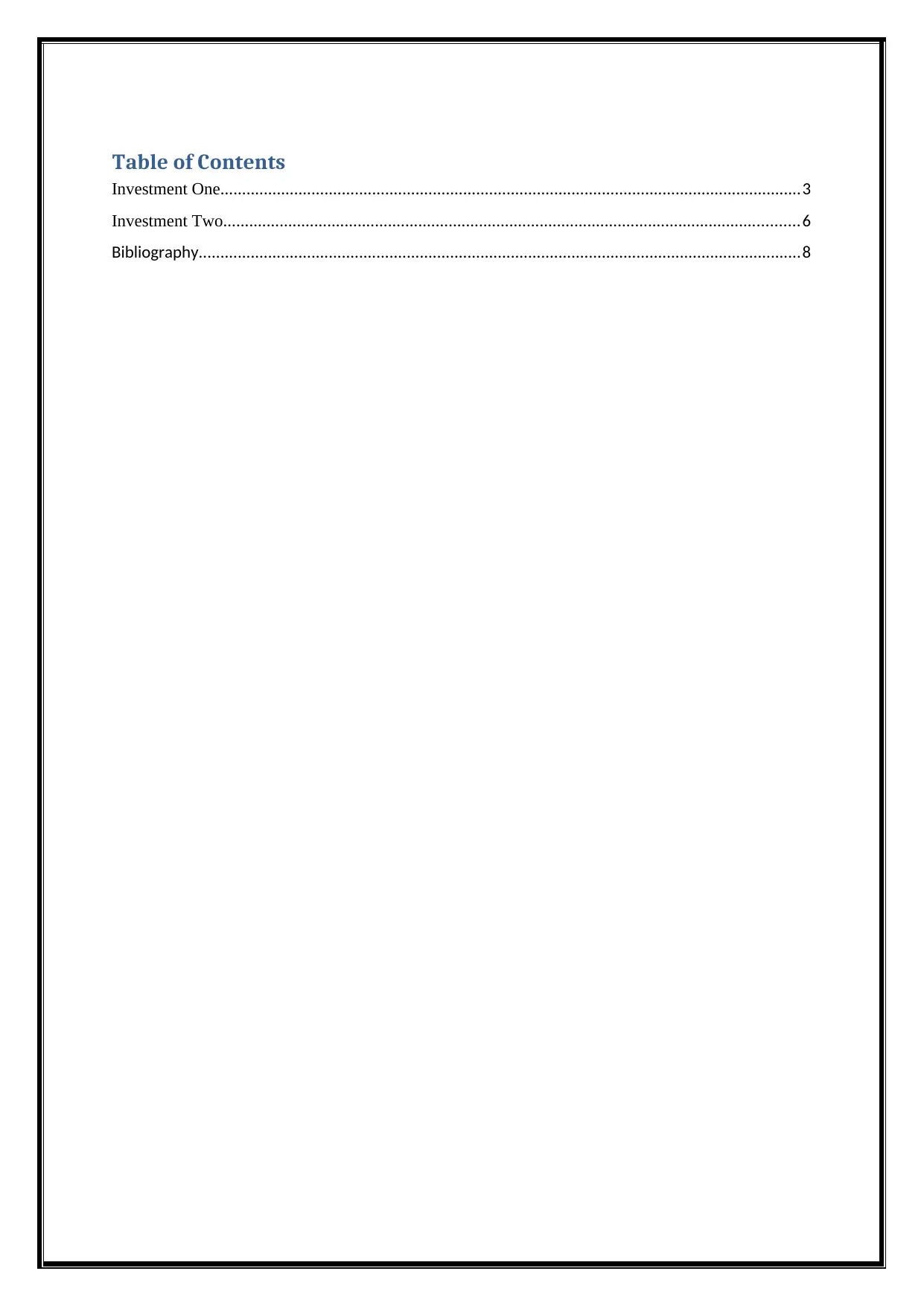
Table of Contents
Investment One......................................................................................................................................3
Investment Two.....................................................................................................................................6
Bibliography...........................................................................................................................................8
Investment One......................................................................................................................................3
Investment Two.....................................................................................................................................6
Bibliography...........................................................................................................................................8
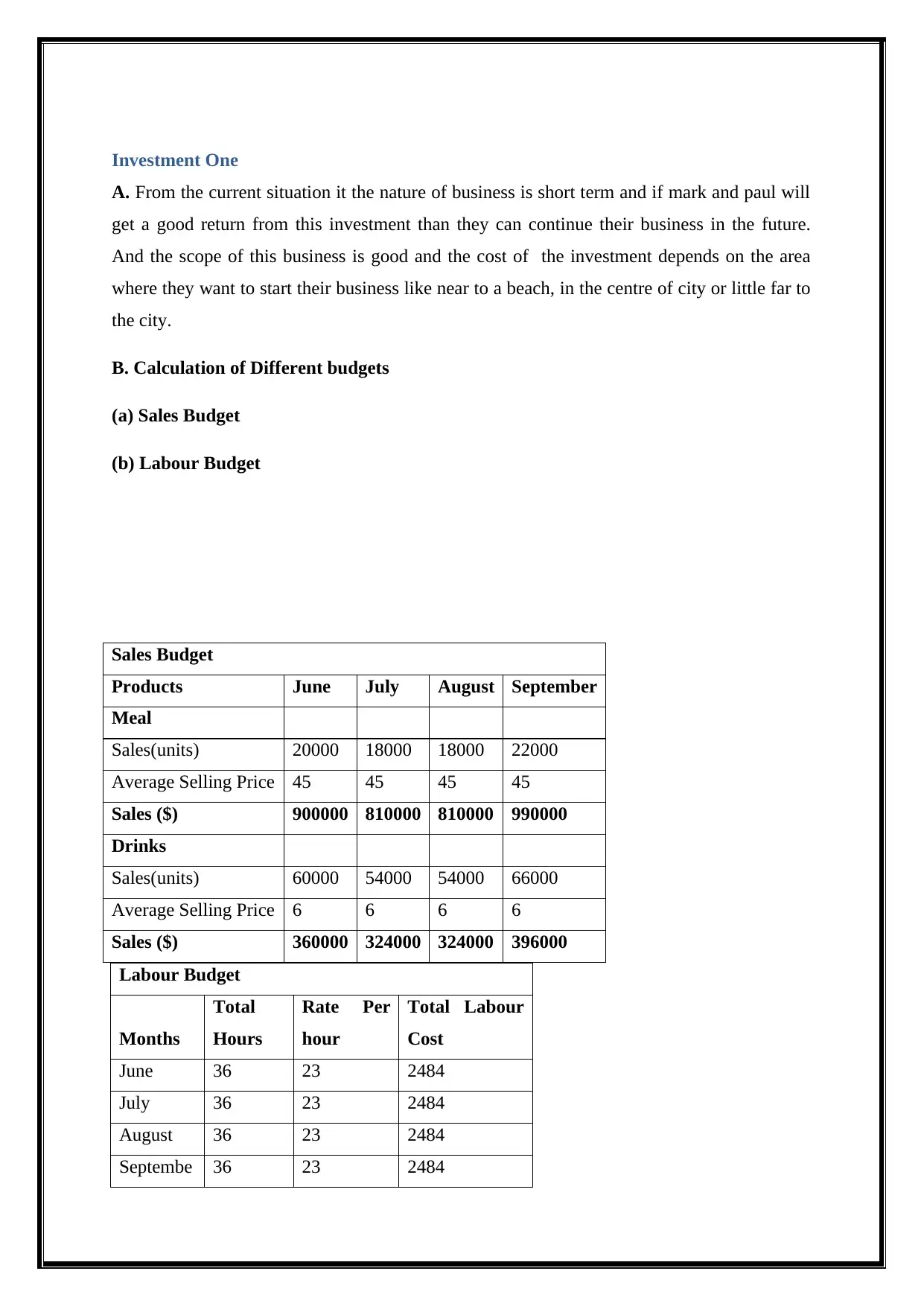
Investment One
A. From the current situation it the nature of business is short term and if mark and paul will
get a good return from this investment than they can continue their business in the future.
And the scope of this business is good and the cost of the investment depends on the area
where they want to start their business like near to a beach, in the centre of city or little far to
the city.
B. Calculation of Different budgets
(a) Sales Budget
(b) Labour Budget
Labour Budget
Months
Total
Hours
Rate Per
hour
Total Labour
Cost
June 36 23 2484
July 36 23 2484
August 36 23 2484
Septembe 36 23 2484
Sales Budget
Products June July August September
Meal
Sales(units) 20000 18000 18000 22000
Average Selling Price 45 45 45 45
Sales ($) 900000 810000 810000 990000
Drinks
Sales(units) 60000 54000 54000 66000
Average Selling Price 6 6 6 6
Sales ($) 360000 324000 324000 396000
A. From the current situation it the nature of business is short term and if mark and paul will
get a good return from this investment than they can continue their business in the future.
And the scope of this business is good and the cost of the investment depends on the area
where they want to start their business like near to a beach, in the centre of city or little far to
the city.
B. Calculation of Different budgets
(a) Sales Budget
(b) Labour Budget
Labour Budget
Months
Total
Hours
Rate Per
hour
Total Labour
Cost
June 36 23 2484
July 36 23 2484
August 36 23 2484
Septembe 36 23 2484
Sales Budget
Products June July August September
Meal
Sales(units) 20000 18000 18000 22000
Average Selling Price 45 45 45 45
Sales ($) 900000 810000 810000 990000
Drinks
Sales(units) 60000 54000 54000 66000
Average Selling Price 6 6 6 6
Sales ($) 360000 324000 324000 396000
⊘ This is a preview!⊘
Do you want full access?
Subscribe today to unlock all pages.

Trusted by 1+ million students worldwide
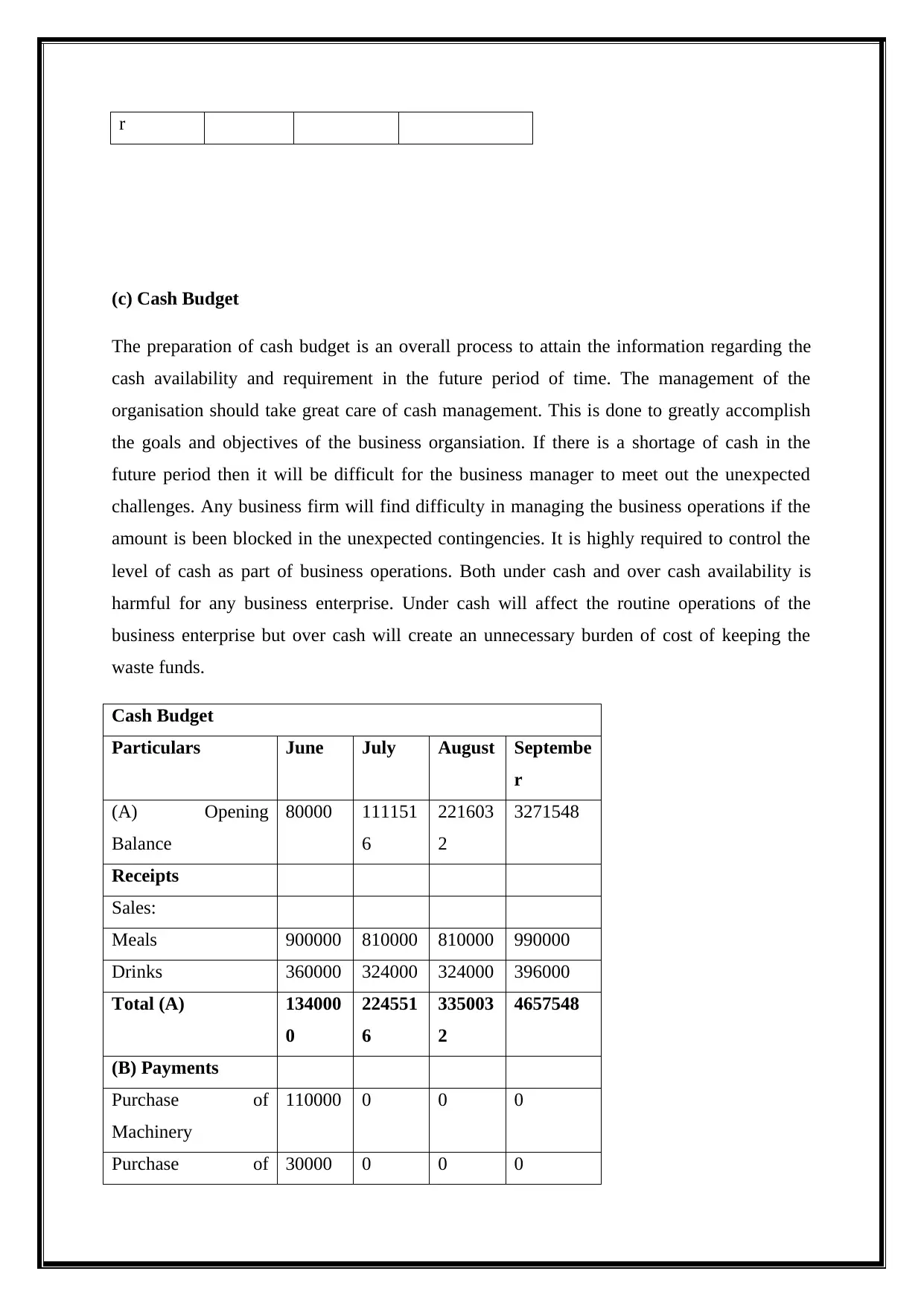
r
(c) Cash Budget
The preparation of cash budget is an overall process to attain the information regarding the
cash availability and requirement in the future period of time. The management of the
organisation should take great care of cash management. This is done to greatly accomplish
the goals and objectives of the business organsiation. If there is a shortage of cash in the
future period then it will be difficult for the business manager to meet out the unexpected
challenges. Any business firm will find difficulty in managing the business operations if the
amount is been blocked in the unexpected contingencies. It is highly required to control the
level of cash as part of business operations. Both under cash and over cash availability is
harmful for any business enterprise. Under cash will affect the routine operations of the
business enterprise but over cash will create an unnecessary burden of cost of keeping the
waste funds.
Cash Budget
Particulars June July August Septembe
r
(A) Opening
Balance
80000 111151
6
221603
2
3271548
Receipts
Sales:
Meals 900000 810000 810000 990000
Drinks 360000 324000 324000 396000
Total (A) 134000
0
224551
6
335003
2
4657548
(B) Payments
Purchase of
Machinery
110000 0 0 0
Purchase of 30000 0 0 0
(c) Cash Budget
The preparation of cash budget is an overall process to attain the information regarding the
cash availability and requirement in the future period of time. The management of the
organisation should take great care of cash management. This is done to greatly accomplish
the goals and objectives of the business organsiation. If there is a shortage of cash in the
future period then it will be difficult for the business manager to meet out the unexpected
challenges. Any business firm will find difficulty in managing the business operations if the
amount is been blocked in the unexpected contingencies. It is highly required to control the
level of cash as part of business operations. Both under cash and over cash availability is
harmful for any business enterprise. Under cash will affect the routine operations of the
business enterprise but over cash will create an unnecessary burden of cost of keeping the
waste funds.
Cash Budget
Particulars June July August Septembe
r
(A) Opening
Balance
80000 111151
6
221603
2
3271548
Receipts
Sales:
Meals 900000 810000 810000 990000
Drinks 360000 324000 324000 396000
Total (A) 134000
0
224551
6
335003
2
4657548
(B) Payments
Purchase of
Machinery
110000 0 0 0
Purchase of 30000 0 0 0
Paraphrase This Document
Need a fresh take? Get an instant paraphrase of this document with our AI Paraphraser
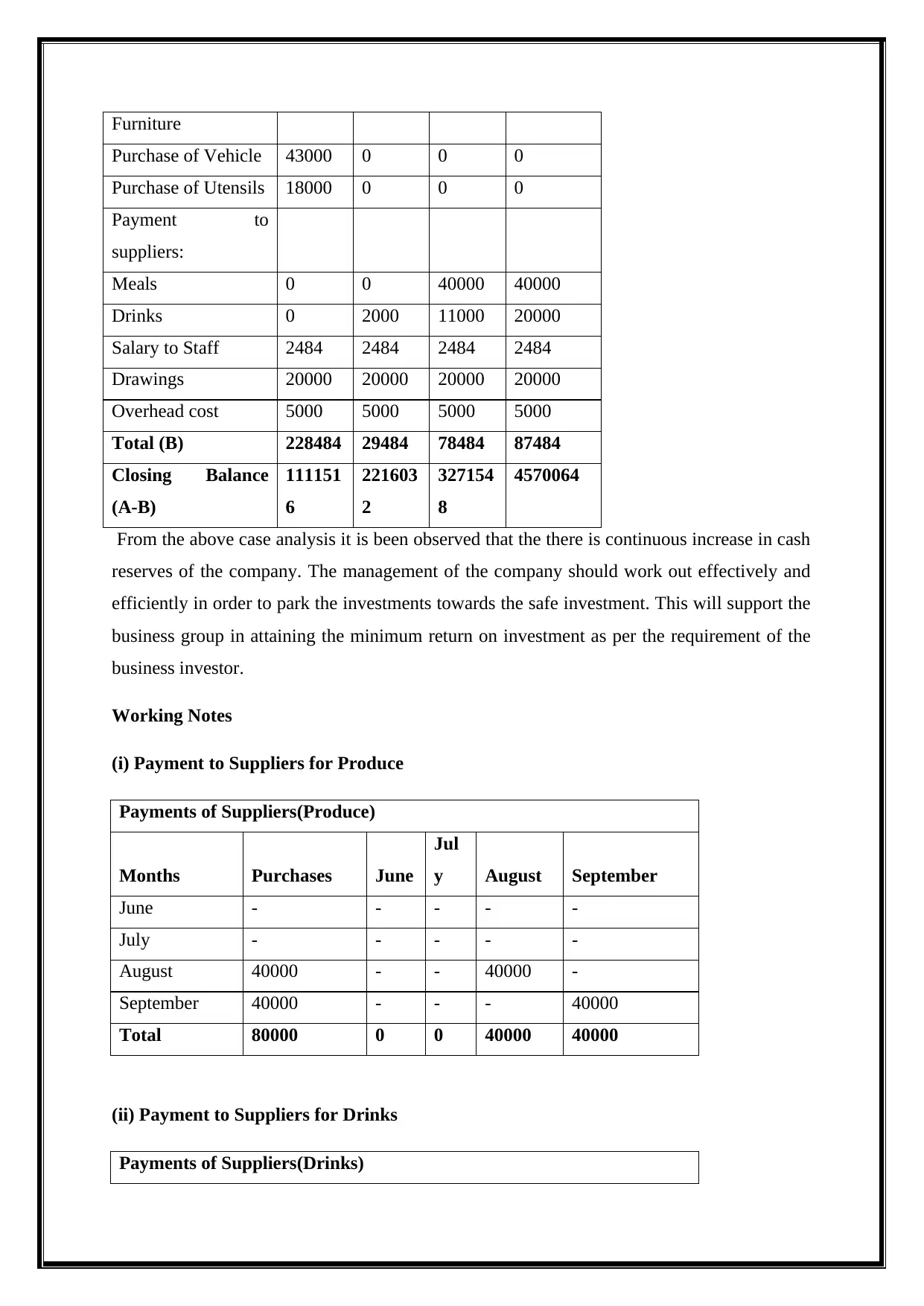
Furniture
Purchase of Vehicle 43000 0 0 0
Purchase of Utensils 18000 0 0 0
Payment to
suppliers:
Meals 0 0 40000 40000
Drinks 0 2000 11000 20000
Salary to Staff 2484 2484 2484 2484
Drawings 20000 20000 20000 20000
Overhead cost 5000 5000 5000 5000
Total (B) 228484 29484 78484 87484
Closing Balance
(A-B)
111151
6
221603
2
327154
8
4570064
From the above case analysis it is been observed that the there is continuous increase in cash
reserves of the company. The management of the company should work out effectively and
efficiently in order to park the investments towards the safe investment. This will support the
business group in attaining the minimum return on investment as per the requirement of the
business investor.
Working Notes
(i) Payment to Suppliers for Produce
Payments of Suppliers(Produce)
Months Purchases June
Jul
y August September
June - - - - -
July - - - - -
August 40000 - - 40000 -
September 40000 - - - 40000
Total 80000 0 0 40000 40000
(ii) Payment to Suppliers for Drinks
Payments of Suppliers(Drinks)
Purchase of Vehicle 43000 0 0 0
Purchase of Utensils 18000 0 0 0
Payment to
suppliers:
Meals 0 0 40000 40000
Drinks 0 2000 11000 20000
Salary to Staff 2484 2484 2484 2484
Drawings 20000 20000 20000 20000
Overhead cost 5000 5000 5000 5000
Total (B) 228484 29484 78484 87484
Closing Balance
(A-B)
111151
6
221603
2
327154
8
4570064
From the above case analysis it is been observed that the there is continuous increase in cash
reserves of the company. The management of the company should work out effectively and
efficiently in order to park the investments towards the safe investment. This will support the
business group in attaining the minimum return on investment as per the requirement of the
business investor.
Working Notes
(i) Payment to Suppliers for Produce
Payments of Suppliers(Produce)
Months Purchases June
Jul
y August September
June - - - - -
July - - - - -
August 40000 - - 40000 -
September 40000 - - - 40000
Total 80000 0 0 40000 40000
(ii) Payment to Suppliers for Drinks
Payments of Suppliers(Drinks)
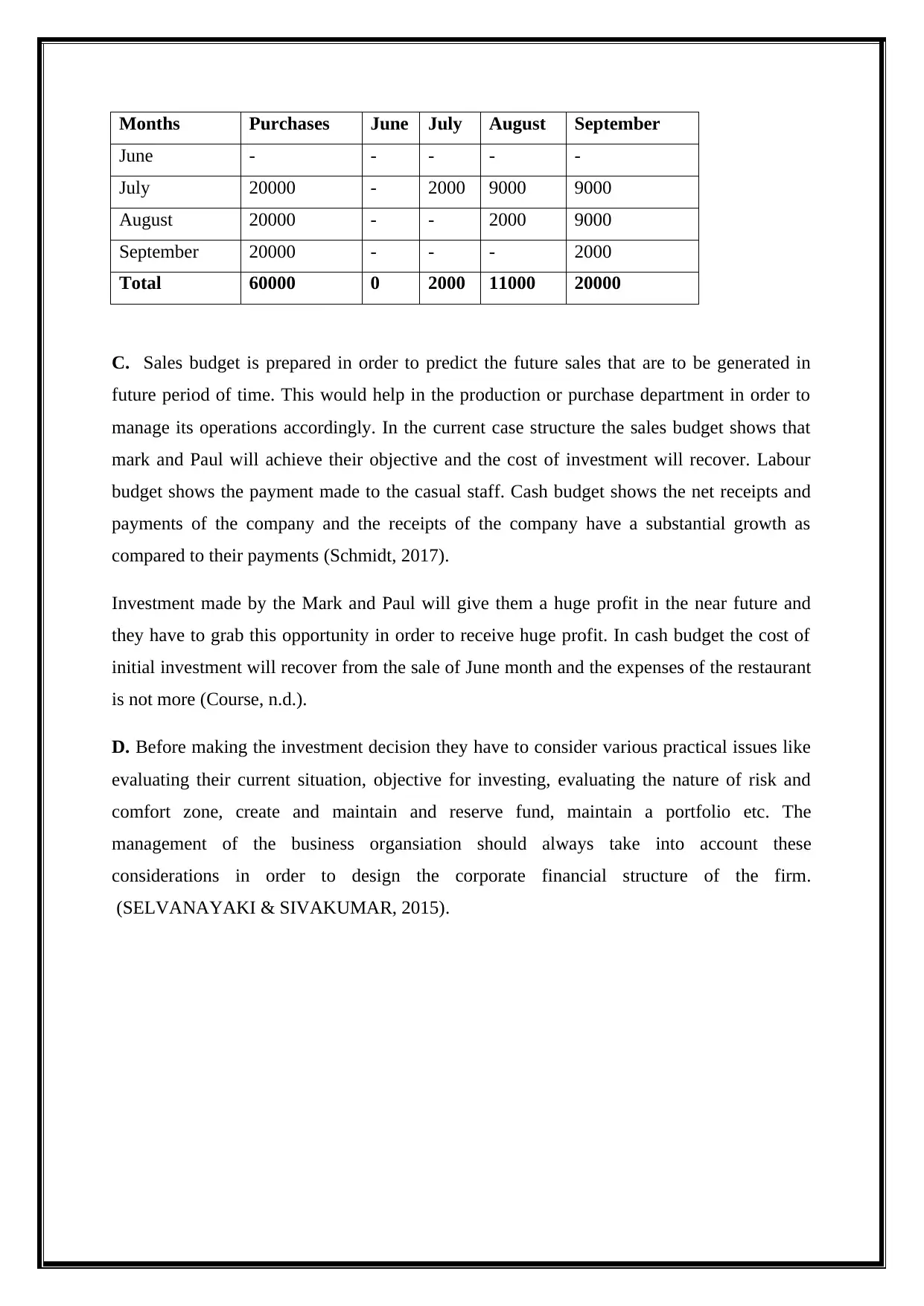
Months Purchases June July August September
June - - - - -
July 20000 - 2000 9000 9000
August 20000 - - 2000 9000
September 20000 - - - 2000
Total 60000 0 2000 11000 20000
C. Sales budget is prepared in order to predict the future sales that are to be generated in
future period of time. This would help in the production or purchase department in order to
manage its operations accordingly. In the current case structure the sales budget shows that
mark and Paul will achieve their objective and the cost of investment will recover. Labour
budget shows the payment made to the casual staff. Cash budget shows the net receipts and
payments of the company and the receipts of the company have a substantial growth as
compared to their payments (Schmidt, 2017).
Investment made by the Mark and Paul will give them a huge profit in the near future and
they have to grab this opportunity in order to receive huge profit. In cash budget the cost of
initial investment will recover from the sale of June month and the expenses of the restaurant
is not more (Course, n.d.).
D. Before making the investment decision they have to consider various practical issues like
evaluating their current situation, objective for investing, evaluating the nature of risk and
comfort zone, create and maintain and reserve fund, maintain a portfolio etc. The
management of the business organsiation should always take into account these
considerations in order to design the corporate financial structure of the firm.
(SELVANAYAKI & SIVAKUMAR, 2015).
June - - - - -
July 20000 - 2000 9000 9000
August 20000 - - 2000 9000
September 20000 - - - 2000
Total 60000 0 2000 11000 20000
C. Sales budget is prepared in order to predict the future sales that are to be generated in
future period of time. This would help in the production or purchase department in order to
manage its operations accordingly. In the current case structure the sales budget shows that
mark and Paul will achieve their objective and the cost of investment will recover. Labour
budget shows the payment made to the casual staff. Cash budget shows the net receipts and
payments of the company and the receipts of the company have a substantial growth as
compared to their payments (Schmidt, 2017).
Investment made by the Mark and Paul will give them a huge profit in the near future and
they have to grab this opportunity in order to receive huge profit. In cash budget the cost of
initial investment will recover from the sale of June month and the expenses of the restaurant
is not more (Course, n.d.).
D. Before making the investment decision they have to consider various practical issues like
evaluating their current situation, objective for investing, evaluating the nature of risk and
comfort zone, create and maintain and reserve fund, maintain a portfolio etc. The
management of the business organsiation should always take into account these
considerations in order to design the corporate financial structure of the firm.
(SELVANAYAKI & SIVAKUMAR, 2015).
⊘ This is a preview!⊘
Do you want full access?
Subscribe today to unlock all pages.

Trusted by 1+ million students worldwide

Paraphrase This Document
Need a fresh take? Get an instant paraphrase of this document with our AI Paraphraser
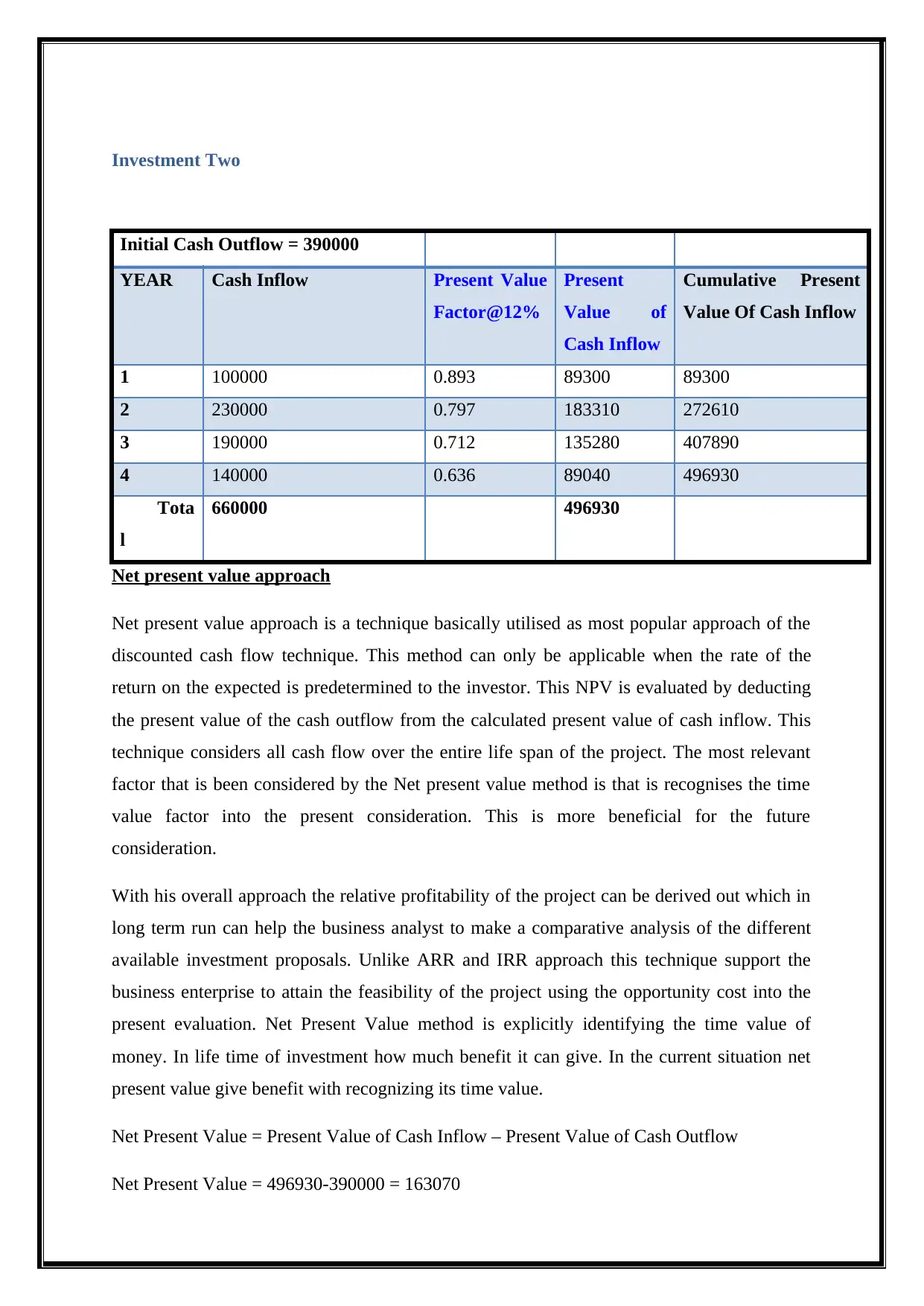
Investment Two
Initial Cash Outflow = 390000
YEAR Cash Inflow Present Value
Factor@12%
Present
Value of
Cash Inflow
Cumulative Present
Value Of Cash Inflow
1 100000 0.893 89300 89300
2 230000 0.797 183310 272610
3 190000 0.712 135280 407890
4 140000 0.636 89040 496930
Tota
l
660000 496930
Net present value approach
Net present value approach is a technique basically utilised as most popular approach of the
discounted cash flow technique. This method can only be applicable when the rate of the
return on the expected is predetermined to the investor. This NPV is evaluated by deducting
the present value of the cash outflow from the calculated present value of cash inflow. This
technique considers all cash flow over the entire life span of the project. The most relevant
factor that is been considered by the Net present value method is that is recognises the time
value factor into the present consideration. This is more beneficial for the future
consideration.
With his overall approach the relative profitability of the project can be derived out which in
long term run can help the business analyst to make a comparative analysis of the different
available investment proposals. Unlike ARR and IRR approach this technique support the
business enterprise to attain the feasibility of the project using the opportunity cost into the
present evaluation. Net Present Value method is explicitly identifying the time value of
money. In life time of investment how much benefit it can give. In the current situation net
present value give benefit with recognizing its time value.
Net Present Value = Present Value of Cash Inflow – Present Value of Cash Outflow
Net Present Value = 496930-390000 = 163070
Initial Cash Outflow = 390000
YEAR Cash Inflow Present Value
Factor@12%
Present
Value of
Cash Inflow
Cumulative Present
Value Of Cash Inflow
1 100000 0.893 89300 89300
2 230000 0.797 183310 272610
3 190000 0.712 135280 407890
4 140000 0.636 89040 496930
Tota
l
660000 496930
Net present value approach
Net present value approach is a technique basically utilised as most popular approach of the
discounted cash flow technique. This method can only be applicable when the rate of the
return on the expected is predetermined to the investor. This NPV is evaluated by deducting
the present value of the cash outflow from the calculated present value of cash inflow. This
technique considers all cash flow over the entire life span of the project. The most relevant
factor that is been considered by the Net present value method is that is recognises the time
value factor into the present consideration. This is more beneficial for the future
consideration.
With his overall approach the relative profitability of the project can be derived out which in
long term run can help the business analyst to make a comparative analysis of the different
available investment proposals. Unlike ARR and IRR approach this technique support the
business enterprise to attain the feasibility of the project using the opportunity cost into the
present evaluation. Net Present Value method is explicitly identifying the time value of
money. In life time of investment how much benefit it can give. In the current situation net
present value give benefit with recognizing its time value.
Net Present Value = Present Value of Cash Inflow – Present Value of Cash Outflow
Net Present Value = 496930-390000 = 163070
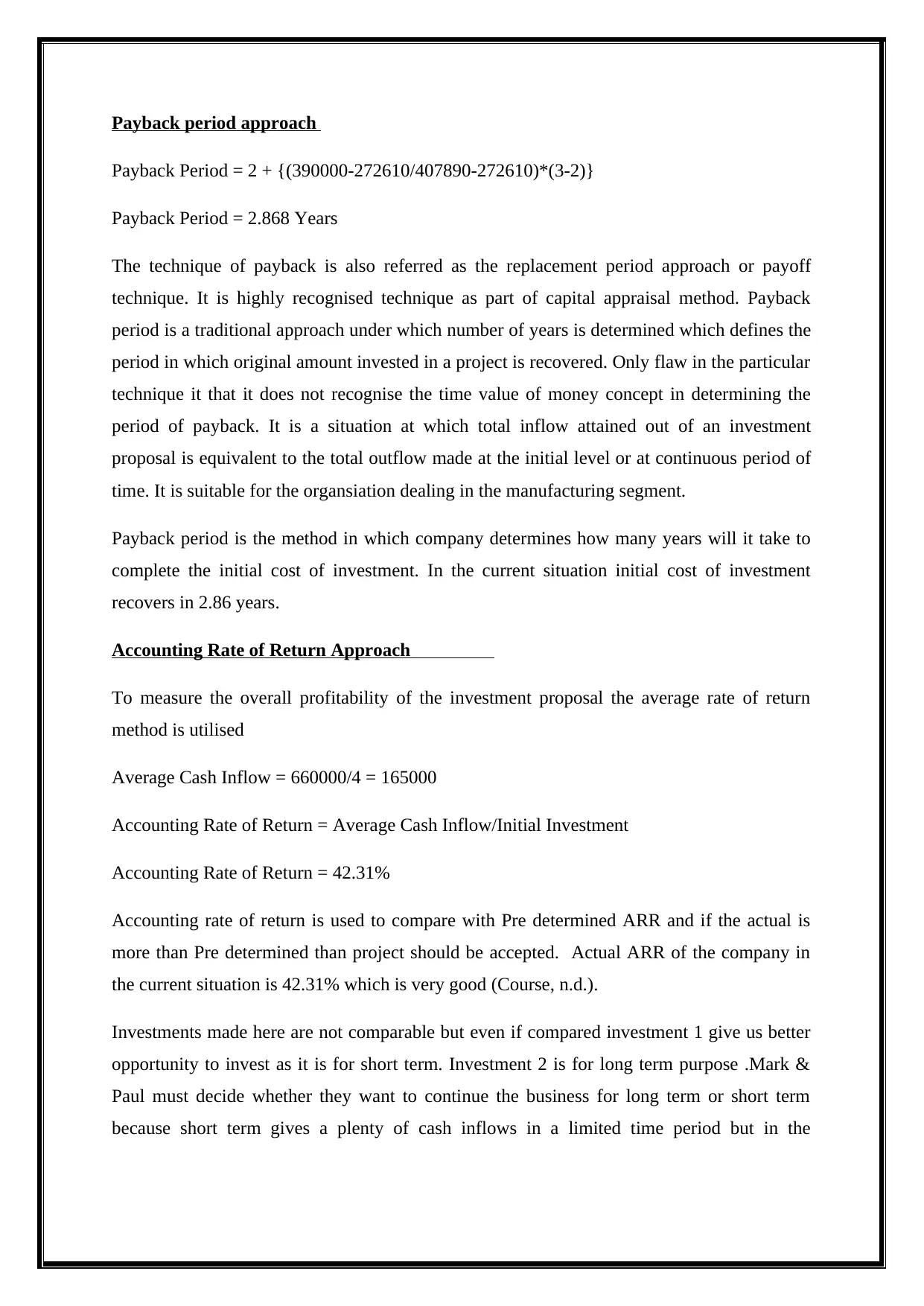
Payback period approach
Payback Period = 2 + {(390000-272610/407890-272610)*(3-2)}
Payback Period = 2.868 Years
The technique of payback is also referred as the replacement period approach or payoff
technique. It is highly recognised technique as part of capital appraisal method. Payback
period is a traditional approach under which number of years is determined which defines the
period in which original amount invested in a project is recovered. Only flaw in the particular
technique it that it does not recognise the time value of money concept in determining the
period of payback. It is a situation at which total inflow attained out of an investment
proposal is equivalent to the total outflow made at the initial level or at continuous period of
time. It is suitable for the organsiation dealing in the manufacturing segment.
Payback period is the method in which company determines how many years will it take to
complete the initial cost of investment. In the current situation initial cost of investment
recovers in 2.86 years.
Accounting Rate of Return Approach
To measure the overall profitability of the investment proposal the average rate of return
method is utilised
Average Cash Inflow = 660000/4 = 165000
Accounting Rate of Return = Average Cash Inflow/Initial Investment
Accounting Rate of Return = 42.31%
Accounting rate of return is used to compare with Pre determined ARR and if the actual is
more than Pre determined than project should be accepted. Actual ARR of the company in
the current situation is 42.31% which is very good (Course, n.d.).
Investments made here are not comparable but even if compared investment 1 give us better
opportunity to invest as it is for short term. Investment 2 is for long term purpose .Mark &
Paul must decide whether they want to continue the business for long term or short term
because short term gives a plenty of cash inflows in a limited time period but in the
Payback Period = 2 + {(390000-272610/407890-272610)*(3-2)}
Payback Period = 2.868 Years
The technique of payback is also referred as the replacement period approach or payoff
technique. It is highly recognised technique as part of capital appraisal method. Payback
period is a traditional approach under which number of years is determined which defines the
period in which original amount invested in a project is recovered. Only flaw in the particular
technique it that it does not recognise the time value of money concept in determining the
period of payback. It is a situation at which total inflow attained out of an investment
proposal is equivalent to the total outflow made at the initial level or at continuous period of
time. It is suitable for the organsiation dealing in the manufacturing segment.
Payback period is the method in which company determines how many years will it take to
complete the initial cost of investment. In the current situation initial cost of investment
recovers in 2.86 years.
Accounting Rate of Return Approach
To measure the overall profitability of the investment proposal the average rate of return
method is utilised
Average Cash Inflow = 660000/4 = 165000
Accounting Rate of Return = Average Cash Inflow/Initial Investment
Accounting Rate of Return = 42.31%
Accounting rate of return is used to compare with Pre determined ARR and if the actual is
more than Pre determined than project should be accepted. Actual ARR of the company in
the current situation is 42.31% which is very good (Course, n.d.).
Investments made here are not comparable but even if compared investment 1 give us better
opportunity to invest as it is for short term. Investment 2 is for long term purpose .Mark &
Paul must decide whether they want to continue the business for long term or short term
because short term gives a plenty of cash inflows in a limited time period but in the
⊘ This is a preview!⊘
Do you want full access?
Subscribe today to unlock all pages.

Trusted by 1+ million students worldwide
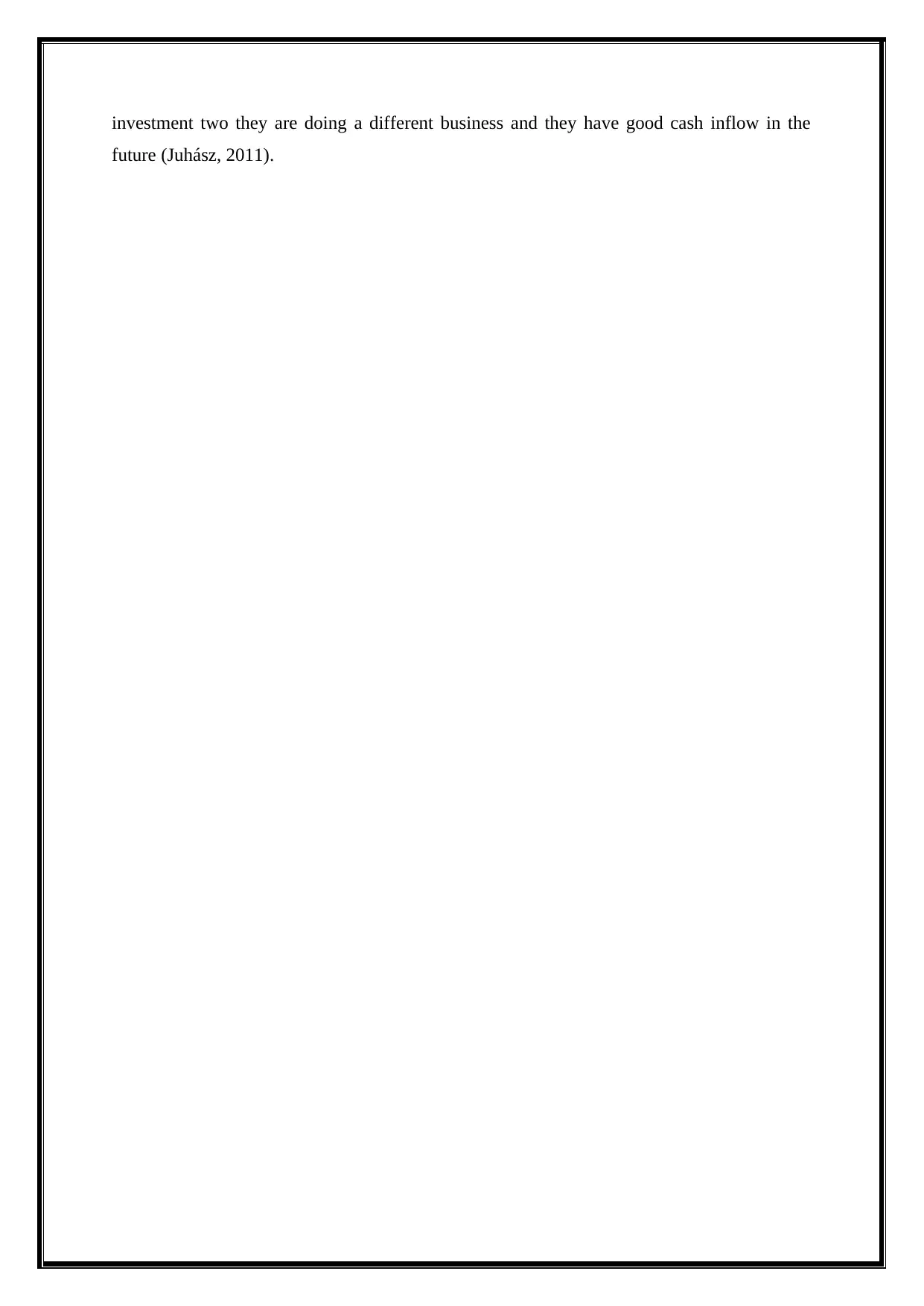
investment two they are doing a different business and they have good cash inflow in the
future (Juhász, 2011).
future (Juhász, 2011).
Paraphrase This Document
Need a fresh take? Get an instant paraphrase of this document with our AI Paraphraser
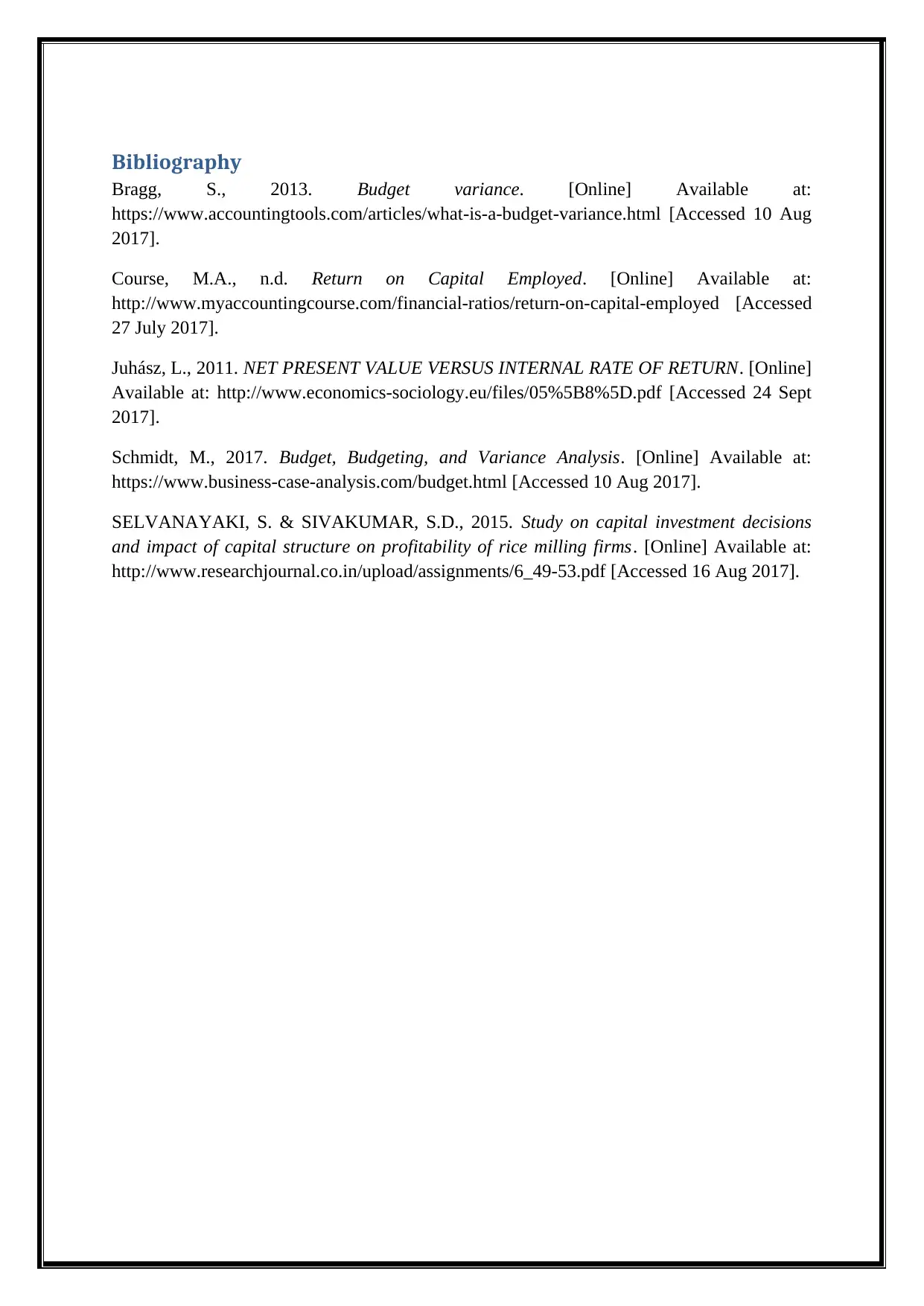
Bibliography
Bragg, S., 2013. Budget variance. [Online] Available at:
https://www.accountingtools.com/articles/what-is-a-budget-variance.html [Accessed 10 Aug
2017].
Course, M.A., n.d. Return on Capital Employed. [Online] Available at:
http://www.myaccountingcourse.com/financial-ratios/return-on-capital-employed [Accessed
27 July 2017].
Juhász, L., 2011. NET PRESENT VALUE VERSUS INTERNAL RATE OF RETURN. [Online]
Available at: http://www.economics-sociology.eu/files/05%5B8%5D.pdf [Accessed 24 Sept
2017].
Schmidt, M., 2017. Budget, Budgeting, and Variance Analysis. [Online] Available at:
https://www.business-case-analysis.com/budget.html [Accessed 10 Aug 2017].
SELVANAYAKI, S. & SIVAKUMAR, S.D., 2015. Study on capital investment decisions
and impact of capital structure on profitability of rice milling firms. [Online] Available at:
http://www.researchjournal.co.in/upload/assignments/6_49-53.pdf [Accessed 16 Aug 2017].
Bragg, S., 2013. Budget variance. [Online] Available at:
https://www.accountingtools.com/articles/what-is-a-budget-variance.html [Accessed 10 Aug
2017].
Course, M.A., n.d. Return on Capital Employed. [Online] Available at:
http://www.myaccountingcourse.com/financial-ratios/return-on-capital-employed [Accessed
27 July 2017].
Juhász, L., 2011. NET PRESENT VALUE VERSUS INTERNAL RATE OF RETURN. [Online]
Available at: http://www.economics-sociology.eu/files/05%5B8%5D.pdf [Accessed 24 Sept
2017].
Schmidt, M., 2017. Budget, Budgeting, and Variance Analysis. [Online] Available at:
https://www.business-case-analysis.com/budget.html [Accessed 10 Aug 2017].
SELVANAYAKI, S. & SIVAKUMAR, S.D., 2015. Study on capital investment decisions
and impact of capital structure on profitability of rice milling firms. [Online] Available at:
http://www.researchjournal.co.in/upload/assignments/6_49-53.pdf [Accessed 16 Aug 2017].
1 out of 11
Related Documents
Your All-in-One AI-Powered Toolkit for Academic Success.
+13062052269
info@desklib.com
Available 24*7 on WhatsApp / Email
![[object Object]](/_next/static/media/star-bottom.7253800d.svg)
Unlock your academic potential
Copyright © 2020–2025 A2Z Services. All Rights Reserved. Developed and managed by ZUCOL.




